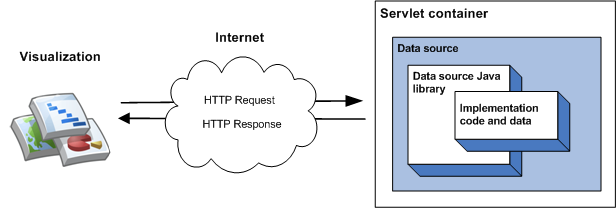הספרייה של מקור הנתונים החזותית ב-Google מאפשרת ליצור בקלות מקור נתונים חזותי. הספרייה מיישמת את פרוטוקול הקידוד של ממשק ה-API של Google ושפת השאילתות. אתם כותבים רק את הקוד הנדרש כדי להפוך את הנתונים לזמינים לספרייה בצורת טבלת נתונים. טבלת נתונים היא טבלה דו-ממדית של ערכים, שבה כל עמודה היא מסוג יחיד. קל יותר לכתוב את הקוד שנחוץ לכם על ידי הקצאת מחלקות מופשטות ופונקציות מסייעות.
היישום הפשוט של הספרייה כולל ירושה מכיתה אחת, יישום פונקציית חבר והפעלה של מקור הנתונים כשרת מודעות במאגר תגים. בהטמעה הפשוטה ביותר, רצף האירועים הבא מתרחש כשהדמיה של מקור נתונים מופעלת:
- מאגר שרת האינטרנט מטפל בשאילתה ומעביר אותה לספריית מקור הנתונים של Java.
- הספרייה מנתחת את השאילתה.
- קוד ההטמעה – הקוד שאתם כותבים – מחזיר לספריית הנתונים את טבלת הנתונים.
- הספרייה מבצעת את השאילתה בטבלת הנתונים.
- הספרייה מעבדת את טבלת הנתונים בתגובה הצפויה באמצעות התצוגה החזותית.
- הקונטיינר של השרת שולח את התגובה לתצוגה החזותית.
ניתן לראות זאת בתרשים הבא:

בקטע תחילת העבודה עם מקורות נתונים מוסבר איך להטמיע את הסוג הזה של מקור נתונים.
אפשר לציין בקוד הנתונים את ההטמעה של מקור הנתונים, וזה בסדר אם מדובר בכמויות קטנות של נתונים סטטיים. לגבי קבוצות נתונים גדולות יותר, סביר להניח שתצטרכו להשתמש במאגר נתונים חיצוני, כמו קובץ חיצוני או מסד נתונים. אם מקור נתונים משתמש במאגר נתונים חיצוני, רצף האירועים הבא מתרחש כשתצוגה חזותית של שאילתה שמפעילה את מקור הנתונים:
- מאגר תגים של הגשה יטפל בשאילתה ויעביר אותה לספריית הנתונים של Java.
- הספרייה מנתחת את השאילתה.
- קוד ההטמעה (הקוד שאתם כותבים) קורא את הנתונים שמאוחסנים במאגר הנתונים ומחזיר לספרייה טבלת נתונים. אם קבוצת הנתונים גדולה, ולחנות הנתונים יש יכולות שאילתה, תוכלו להשתמש ביכולות האלה כדי לשפר את היעילות של מקור הנתונים.
- הספרייה מבצעת את השאילתה בטבלת הנתונים.
- הספרייה מעבדת את טבלת הנתונים בתגובה הצפויה באמצעות התצוגה החזותית.
- הקונטיינר של השרת מציג את התגובה לתצוגה החזותית.
ניתן לראות זאת בתרשים הבא:

בקטע שימוש במאגר נתונים חיצוני מוסבר איך להטמיע את הסוג הזה של מקור נתונים.
